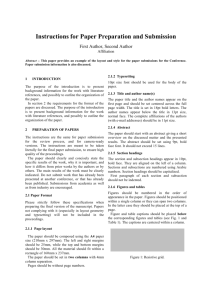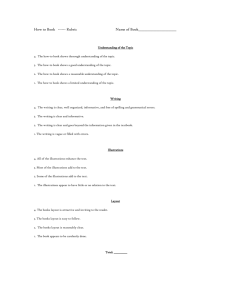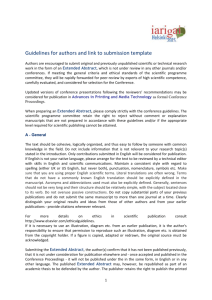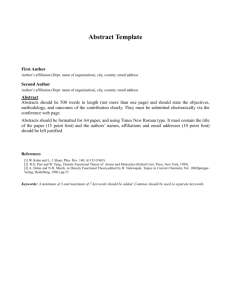INSTRUCTIONS FOR PREPARATION OF PAPERS
advertisement
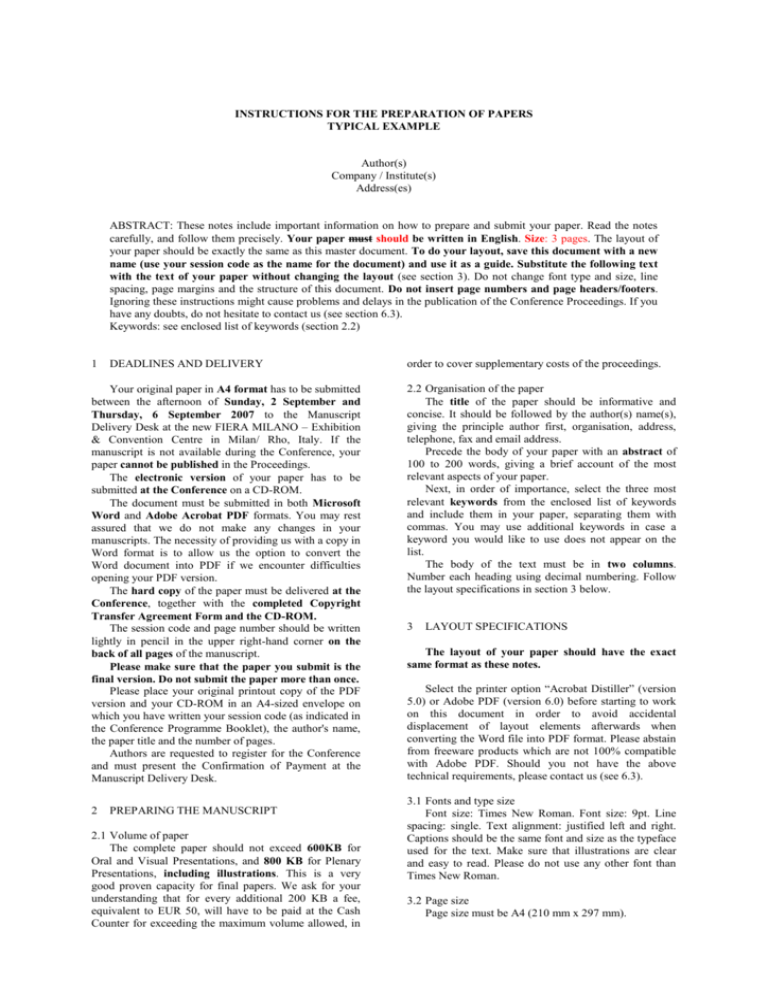
INSTRUCTIONS FOR THE PREPARATION OF PAPERS TYPICAL EXAMPLE Author(s) Company / Institute(s) Address(es) ABSTRACT: These notes include important information on how to prepare and submit your paper. Read the notes carefully, and follow them precisely. Your paper must should be written in English. Size: 3 pages. The layout of your paper should be exactly the same as this master document. To do your layout, save this document with a new name (use your session code as the name for the document) and use it as a guide. Substitute the following text with the text of your paper without changing the layout (see section 3). Do not change font type and size, line spacing, page margins and the structure of this document. Do not insert page numbers and page headers/footers. Ignoring these instructions might cause problems and delays in the publication of the Conference Proceedings. If you have any doubts, do not hesitate to contact us (see section 6.3). Keywords: see enclosed list of keywords (section 2.2) 1 DEADLINES AND DELIVERY Your original paper in A4 format has to be submitted between the afternoon of Sunday, 2 September and Thursday, 6 September 2007 to the Manuscript Delivery Desk at the new FIERA MILANO – Exhibition & Convention Centre in Milan/ Rho, Italy. If the manuscript is not available during the Conference, your paper cannot be published in the Proceedings. The electronic version of your paper has to be submitted at the Conference on a CD-ROM. The document must be submitted in both Microsoft Word and Adobe Acrobat PDF formats. You may rest assured that we do not make any changes in your manuscripts. The necessity of providing us with a copy in Word format is to allow us the option to convert the Word document into PDF if we encounter difficulties opening your PDF version. The hard copy of the paper must be delivered at the Conference, together with the completed Copyright Transfer Agreement Form and the CD-ROM. The session code and page number should be written lightly in pencil in the upper right-hand corner on the back of all pages of the manuscript. Please make sure that the paper you submit is the final version. Do not submit the paper more than once. Please place your original printout copy of the PDF version and your CD-ROM in an A4-sized envelope on which you have written your session code (as indicated in the Conference Programme Booklet), the author's name, the paper title and the number of pages. Authors are requested to register for the Conference and must present the Confirmation of Payment at the Manuscript Delivery Desk. 2 PREPARING THE MANUSCRIPT 2.1 Volume of paper The complete paper should not exceed 600KB for Oral and Visual Presentations, and 800 KB for Plenary Presentations, including illustrations. This is a very good proven capacity for final papers. We ask for your understanding that for every additional 200 KB a fee, equivalent to EUR 50, will have to be paid at the Cash Counter for exceeding the maximum volume allowed, in order to cover supplementary costs of the proceedings. 2.2 Organisation of the paper The title of the paper should be informative and concise. It should be followed by the author(s) name(s), giving the principle author first, organisation, address, telephone, fax and email address. Precede the body of your paper with an abstract of 100 to 200 words, giving a brief account of the most relevant aspects of your paper. Next, in order of importance, select the three most relevant keywords from the enclosed list of keywords and include them in your paper, separating them with commas. You may use additional keywords in case a keyword you would like to use does not appear on the list. The body of the text must be in two columns. Number each heading using decimal numbering. Follow the layout specifications in section 3 below. 3 LAYOUT SPECIFICATIONS The layout of your paper should have the exact same format as these notes. Select the printer option “Acrobat Distiller” (version 5.0) or Adobe PDF (version 6.0) before starting to work on this document in order to avoid accidental displacement of layout elements afterwards when converting the Word file into PDF format. Please abstain from freeware products which are not 100% compatible with Adobe PDF. Should you not have the above technical requirements, please contact us (see 6.3). 3.1 Fonts and type size Font size: Times New Roman. Font size: 9pt. Line spacing: single. Text alignment: justified left and right. Captions should be the same font and size as the typeface used for the text. Make sure that illustrations are clear and easy to read. Please do not use any other font than Times New Roman. 3.2 Page size Page size must be A4 (210 mm x 297 mm). Margins: top: 32mm; bottom: 19mm; left: 25mm; right: 25mm. Text or images can't be outside these margins. The body of the text must be in two equal columns. The width of the columns should be 73,6mm. 3.3 Layout of the text Begin at the top of the first page with the title of the paper, in capital letters, bold and centered. Leave one blank line between the title and the name of the author(s), and list the surname preceded by the initial of the first name. On the next lines, give the name of the firm or institute, wherever applicable, and the full address. When several authors prepare a paper, the name of the principal author should appear first and the name of every institute should be easy to depict. Next, leave two blank lines and then type an abstract of no more than 200 words (indent the whole block as at the top of this document). At the end of the abstract, give your list of keywords. Leave another two blank lines between the abstract and the body of the paper, which should be typed in two columns. Good example with contrasting colours: Bad example with fill patterns: 3.4 Headings Leave two blank lines before each section and one blank line before the heading of each sub-section. Headings and sub-headings should be numbered (e.g. 3, 3.1, 3.2). Separate the numbers from the text of the heading with two spaces. There should be no blank line after the title of the sub-sections, only an indentation to indicate the beginning of a paragraph. Section headings should be in capital letters, sub-section headings in upper and lower case. Headings should be normal text – not underlined or in bold. Figure 1: Clear line drawings are essential 4 Table I: Standing waves ratio ADDITIONAL COMPONENTS 4.1 Illustrations Illustrations (drawings, graphs, photographs, etc.) should not exceed 50% of the whole paper and should be placed near their citation. Accepted formats are: .jpg, .bmp and .gif. Illustrations should have a resolution of 300 dpi, using simple colours (Standard + RGB) and be placed at 100% scale (i.e. if an illustration covers the full column width, it should be of approx. 860 pixels). Illustrations should not be taken from previously-printed material. Illustrations should have the layout in line with the text (right click on object - format object – layout – in line with text, which should be the left most option in the layout dialogue window). Figures must be numbered (e.g. Fig. 1) in the text and in the figure caption. Captions should be clear enough to allow comprehension of the illustration without reference to the text. Graphs must not be imported from Excel, but be inserted as a picture (.jpg, .bmp or .gif). Please use simple contrasting colours (Standard + RGB) instead of fill patterns (see good/bad example). Please make sure that the PDF file size of the final document does not exceed 600 KB (Orals & Visuals) or 800 KB (Plenaries). If your document size should be larger than this, verify the resolution and scale of the inserted images. 4.2 Tables Tabular presentation of data is an easy way of condensing many items. Refer to tables by using Roman numerals. All tables must be numbered and captioned (see Table I). Standing waves ratio Reflection coefficient Phase 110MHz 120MHz 130MHz 1.86 1.73 1.40 0.32 0.28 0.16 3.78 3.89 4.02 4.3 References References should not appear as footnotes but should be gathered together at the end of the text. When referring to them in the text, type the corresponding reference number in brackets [1]. References should be numbered: [1] M. Smith, A. Miller, Proceedings 17th European Photovoltaic Solar Energy Conference, Vol. I (2002) 903. [2] K.W. Boer, Solar Cells 16 (1996) 591. 5 SPECIAL REQUESTS FOR THE PDF VERSION 5.1 Printer Select Acrobat Distiller (version 5.0) or Adobe PDF (version 6.0) as the printer option to convert your Word file into PDF version. Go to printer properties and click on “Acrobat PDF settings”, then choose as conversion settings: “Press” quality. 5.2 Password / Security Please do not use passwords, nor security when making your PDF file. You may rest assured that we do not make any changes in your manuscripts. As the header and page numbering will be added by us, we need to ensure that your PDF file is not password protected. 6 OTHER POINTS 6.1 Permissions Authors are fully responsible for their papers. They must take the necessary steps to obtain permission for using any material that might be protected by copyright. 6.2 Copyright Please be aware that on delivery of your manuscript, you transfer the copyright to WIP, publisher of the proceedings. 6.3 Further information Papers must be submitted to the Manuscript Delivery Desk at the Conference. All authors must supply a printout of their paper and the completed Copyright Transfer Agreement Form. All requests regarding the preparation of the paper should be addressed to: 7 SUMMARY OF THESE NOTES • Use this layout as a guide to write your paper. Write your paper directly on this document and save it with the name of the session code. Select the printer option “Acrobat Distiller” (version 5.0) or Adobe PDF (version 6.0) before starting to work on this document. Write your paper in English, A4 format, Font Times New Roman, 9 pt. Submit your paper at the Conference on a CD-ROM, both in Microsoft Word and Adobe Acrobat PDF format. Submit the hard copy of your paper (printed from the PDF version) at the Conference. Submit only the final version of your paper and just once. Use contrasted pictures/illustrations placed at 100% (do not resize them in Microsoft Word), 300 dpi with Standard + RGB colors in .jpg, .bmp or .gif format. The size of the final document in PDF can not be larger than 600 KB for Oral and Visual Papers and 800 KB for Plenary Papers. • • • • • • • If you need any further assistance, please contact us. Thank you very much for your kind attention. The Publisher
